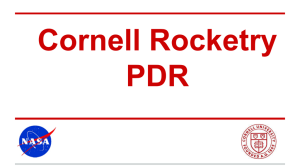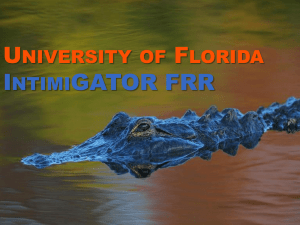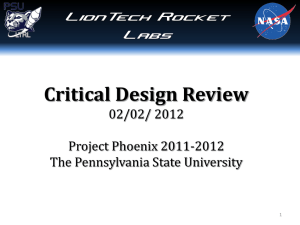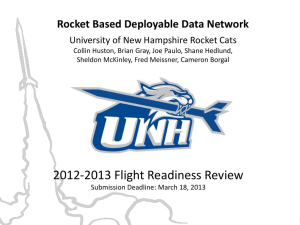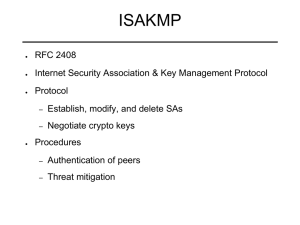spinning_payload_pdr
advertisement
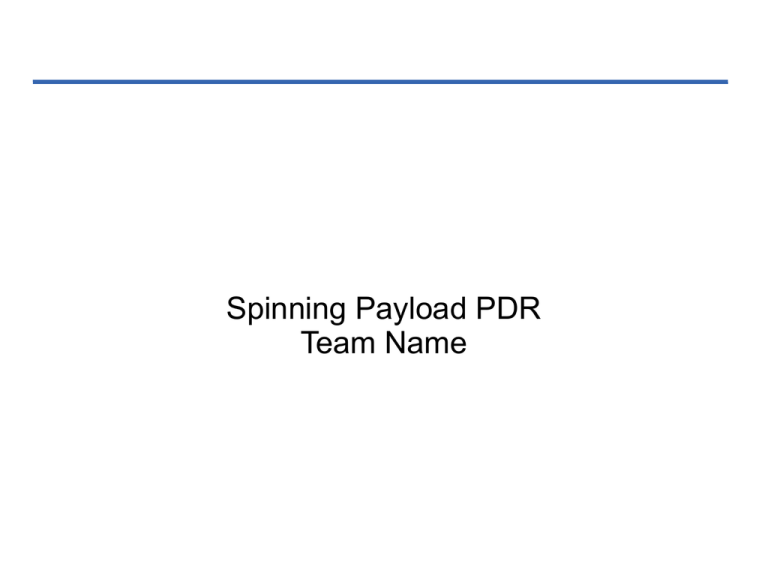
Spinning Payload PDR Team Name Presentation Outline Provide a simple outline of the presentation If possible, indicate team member(s) who will preset each section Team Organization Single slide listing team members and role Can use an organization chart Acronyms Provide a list of acronyms used throughout the presentation Used as refernce only. Does not need to be read through System Overview Presenter name here Mission Summary Overview of mission objectives Include any external objectives System Requirement Summary Overview of system (mission) level requirements Use bullets or table to demonstrate understanding of requirements Include requirements for the payload Include requirements for the rocket System Level Trade and Selection Present preliminary system-level concepts considered Configurations of rocket and payload Present criteria for final configuration selection Include sketches and diagrams of various concepts considered. Include variations on CONOPS considered System Concept of Operations Provide overview of operations of the system from launch to landing and payload operations. Launch and descent operations payload operations Post-launch recovery Simple flow diagrams and cartoons are a good way to present the CONOPS Physical Layout Diagram of rocket showing major components Dimensions payload location Major components involved in deploying payload Diagram of rover Dimensions Identify major components and their locations Rocket Design Presenter Name Overview of Rocket Describe overall rocket design Identify major components and locations Rocket weight Motor selection Airframe diameter Fins size and number of fins Length of rocket Identify CP and CG and distance between CP and CG Explain overall operation including rover deployment and recovery deployment Rocket Materials Airframe material Fin material Nosecone material Type of adhesives used Rail button type Motor retention Rocket Recovery System Parachute selection Harness Type of shock cord, lengths and strengths Linkages and strengths Attachment points, eyebolts, fender washers, etc. Parachute protection Rocket Recovery System Deployment Method Motor ejection or Altimeter Altimeter selection Altimeter wiring diagram Charge installation process ( provide steps of operations) Arming process (provide steps of operations) Safety practices to avoid accidental firing during preparations Ejection charge powder selection and quantity determination Rocket Motor Selection Primary motor selection Backup motor selection Thrust to weight ratio Flight simulations Identify simulation software Expected altitude Spinning Payload Design Spinning Payload Design Overview Show block diagram or picture of payload Identify major components Dimensions Mass of payload Spinning Payload Mechanics Mechanical design description Structure Component placement Material description Spinning Payload Recovery Design Describe the auto-gyro design Spinning Payload Electronics Electronic block diagram Processors Memories Sensors Drivers for mechanisms and actuators Spinning Payload Power Battery selection and configuration Power capacity Mounting method Protection circuits Short circuit Over-discharge for lithium ion cells Spinning Payload Power Distribution Electrical Power System Design Regulators Power distribution to subsystems, mechanisms, actuators Spinning Payload Software Design Flow Chart of software Identify software states and how software transitions to each state Power up Integration Launch Deployment Landing Ground operation Spinning Payload Payload Integration Describe design and construction of payload section Any mechanisms that interact with Spinning Payload Describe how Spinning Payload is configured for payload integration Describe process of payload integration Ground Station Design Ground Station Architecture Show diagram of ground station Include antennas, computers, etc. Identify components Ground Station Software Describe software for the ground station. What software is used, what is programmed. Testing Spinning Payload Testing Describe testing of Spinning Payload subsystems Describe testing during subsystem integration Describe functional testing Describe testing with ground station Rocket Testing Describe testing of rocket Parachute deployment testing Payload deployment testing Flight test Flight Operations Describe procedures during launch day Rocket preparation Spinning Payload Preparation Spinning Payload integration into rocket Preparations at the launch pad Program Schedule Show schedule of the complete development cycle up to time of launch Component and service schedule When components are bought and lead times for components Services required (contract machining, PCB, etc.) Program Budget Show budget for all parts of the program Components Services Travel expenses Summary Describe state of development efforts, any accomplishments, issues, and way forward Instructions Slides are a template describing information needed. Each section can be expanded into more slides as needed. Don't try cramming each listed topic on the same slide. Place team/school logo in the top left corner. Put page numbers on the slides. Formatting and background can be customized. This document is distributed as PDF to force you to make your own. Do not include animations or videos as reviewers may not have compatible software. Submit PDR in pdf format for maximum compatibility. Do not include this slide in the presentation. Yes, some one will.


